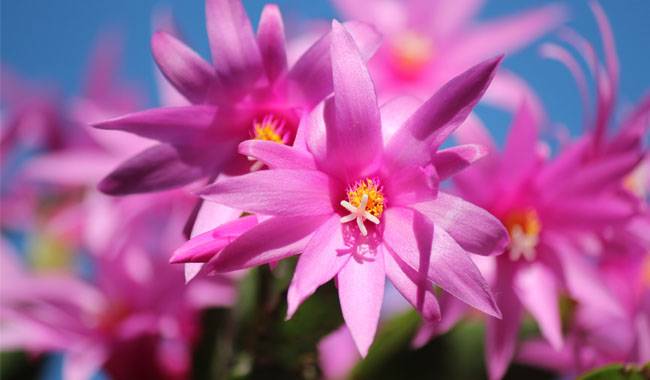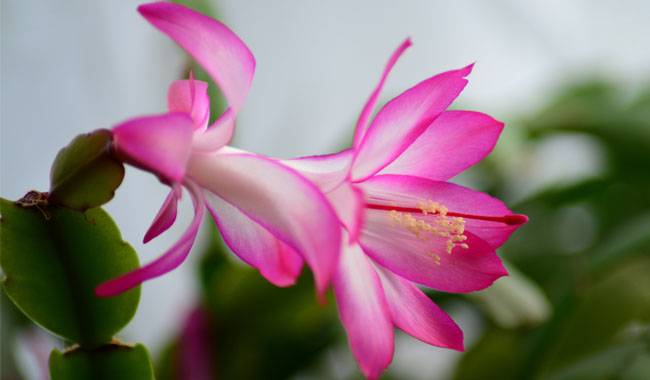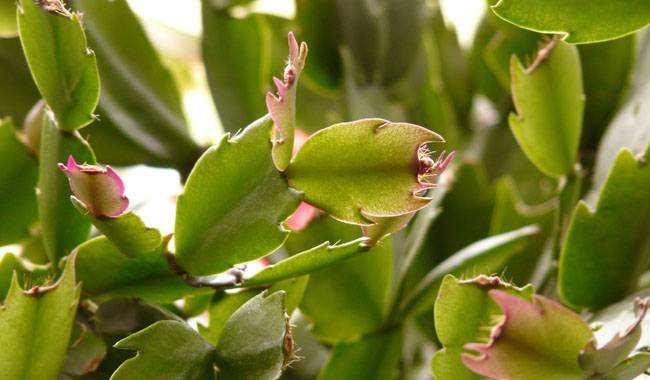
Despite the many similarities between the Easter cactus plant and the Schlumbergera plant, which sometimes lead to interesting confusion, the Easter cactus plant becomes an exceptional cactus for anyone who dares to bring it into their home. The Easter cactus plant has brightly colored flower stars, clear, pendulous branches that are demanding and easy to grow. With a suitable habitat, it can be kept to a minimum. However, without proper preparation, it is impossible to enjoy the true abundance of flowers. It is no coincidence that the Easter cactus plant, once almost forgotten and regarded as obsolete, is now popular again. You will learn how to grow the easter cactus plant in ThumbGarden’s article.
EASTER CACTUS PLANT DESCRIPTION
Easter cactus plant (Rhipsalidopsis) or Schlumbergera gaertneri is one of the most popular flowering forest cacti. They are often confused with the Schlumbergera plant, but if you pay attention, everything falls into place. Even the folk nickname points out the most significant difference – the time of flowering. purple Decembrist (Schlumbergera) flowers in winter, Easterling Easter cactus plant in spring.
There are, of course, quite a few other differences. The developmental cycles are different: Easter cactus plants flower eventually during asexual reproduction followed by dormancy, whereas Easter cactus plants flower after dormancy and before asexual reproduction.
The status of the Easter cactus plant itself is also complicated. Officially, scientists have still not made a decision. The debate has not stopped whether to reclassify the Easter cactus plant as Hatiora gaertneri, as it was ten years ago, or reclassify it as Epiphyllum russellianum.
But it is worth forgetting the taxonomic nuances and focusing on the plant itself. More importantly, the indoor Easter cactus plant is not a species plant, but a variety and hybrid of complex origin, with the 20 inches (50 cm) long shoots of Easter cactus plant Hartneri (Rhipsalidopsis x Gaertner) and the dwarf Rhipsalidopsis rosea, up to 6 inches (15 cm).
The Easter cactus plant is an epiphytic cactus with pendulous branches in a delightful variety of species and forms. The shoots are up to 20 inches (50 cm) long and branch densely, forming lush bushes and terraces. The segments up to 2 inches (5 cm) long and 1 inch (2.5 cm) wide are flat, with slightly wavy edges and rounded angles. It is smoother than the sharp serrations of the Schlumbergera plant and has a more prominent edge with a reddish border and visible bristle-like prickles. Another nice difference from other flowering cacti is that the Easter cactus plant has a bright, colorful green color.
Easter cactus plant traditionally flowers in the first half of spring, during Easter in March and April. However, it starts after a dormant period in autumn and winter (this is where the Easter cactus plant differs from the Schlumbergera plant, which ‘rests’ after flowering in spring).
The tubular, star-shaped flowers of the Easter cactus plant, up to 2 inches (5 cm) in diameter, are symmetrical and pleasingly regular, with an even corolla (the petals do not curl backward, unlike Easter cactus plant.) The flowers of the Easter cactus plant bloom along the entire length of the shoot, not just at the top.
The orange, pink and red flowers of the Easter cactus plant in neon and pastel variants are decorative enough in themselves. And the abundance of flowers makes these cacti look even more dazzling.
GROWING CONDITIONS FOR THE EASTER CACTUS PLANT OUTDOORS

Easter cactus plants have proven to be a challenge for many hobbyists as they will not flower without a cool environment. Otherwise, they are fairly undemanding and can be placed in a fairly standard location.
Lighting and placement
Easter cactus plant is best kept out of direct sunlight, but the area where it is placed should be kept as bright as possible. Lighting on an eastern or northern windowsill is ideal. Even on a western window, the plant will suffer from too much light. The maximum distance from a window is 60 inches (1.5 m) and in the south and west-facing rooms, it is best to move the cactus indoors. During the dormant period, no additional light is needed, but the location of the Easter cactus plant should be chosen before germination, as it is highly undesirable to move the plant from the moment the buds are formed.
During the flowering period, the plants should not be touched, but during the summer when the vegetation is active it is advisable to turn the plants regularly to allow for even development.
Temperature and ventilation
The usual room temperature is suitable for Rhipsalidopsis during active growth. the optimum temperature in summer is between 64-77 °F (18-25 °C). In hot weather, plants require high atmospheric humidity and frequent ventilation (or being outdoors).
In order for Easter cactus plants to flower, you must take care of a suitably cool dormancy period by lowering the temperature in January and February, or even earlier if possible. 53 °F (12 °C) is the ideal temperature to prepare the plant for flowering. The permissible ‘regime’ change is 50-57 °F (10-14 °C), at which temperature flower buds will still be deposited. Warmer temperatures above 59 °F (15°C) will not produce flowering Rhypsalidopsis.
Easter cactus plants require gentle ventilation and free air circulation around the shrub. In summer these plants can be placed in a sheltered and shady spot in the garden or on a balcony.
HOME CARE FOR EASTER CACTUS PLANT

Water vigorously but carefully, give the proper nutrients, and maintain hygiene – Easter cactus plant plants love attention and consistency.
Watering and humidity
Easter cactus plants are afraid of over-watering, but they should be watered frequently and heavily in summer. It is best to drain the trays of water immediately. The substrate only needs to dry out at the top but never completed before the next watering.
During the resting period, the cactus should be kept almost dry. Watering should be kept to a minimum, and the roots and shoots kept moist.
The water should be at the same temperature as the air. Hard water can be acidified, but initially, it is best to choose the ‘safest’ soft option (e.g., melted pure water).
Easter cactus plants prefer high humidity. The green leaves, but not the buds or flowers, can be sprayed regularly. Another option is to install a humidifier ( even homemade ).
Feeding and fertiliser composition
Too much fertiliser is just as dangerous as too little. Easter cactus plants can be fertilised during the growing season, starting a month before the expected flowering and continuing through the summer. Fertiliser for cacti (or half of the fertiliser for flowering plants) should ideally be applied every 3 weeks.
Pruning and trimming an easier cactus plant
Only diseased branches need to be pruned hygienically, and the plugs treated and dried. Tillering can be encouraged by pinching off the top segments and shortening the long ‘warts’ if desired.
Transplants, containers and substrates
Even young Easter cactus plants do not have time to assimilate the substrate in containers within a year. Repotting is best done as they grow, and given the development of the soil, tentatively every 2-3 years, after the plant has flowered.
Easter cactus plants are best grown in a special light and loose succulent soil mixes. Home-made mixes with loose components (e.g., equal parts leaf and turf soil, sand and perlite or vermiculite) are also suitable. The optimum pH is between 5.0 and 6.0.
Place a 2 inch (5 cm) high drainage layer in the bottom of the pot. Transplanting should be carried out with care. The compact roots of this plant are easily traumatised and should be carefully inspected to remove any damage. The depth should be strictly controlled so as not to submerge the green part of the stem and care should be taken not to disturb the habitual position. The soil is lightly curled, but not excessively so.
After transplanting, Easter cactus plants should be placed in a semi-shady area. The substrate should be kept as moist as possible without rushing to resume the usual watering until growth has started.
Diseases, pests and cultivation problems
Easter cactus plants can dry out and deform in the presence of heat, insufficient light, excessive watering, and excessively dry air. If the substrate is moist, it will rot quickly in cold conditions. Cessation of growth is always an indication of a lack of light or depleted soil.
Amongst the pests, they are rare but rarely scab, spider mites, and mealybugs. Corrective care helps, but it is also best to start insecticide treatment immediately. Fusarium, phylloxera, and rot require pruning of damaged parts and repeated treatment with systemic fungicides.
Easter cactus plant propagation
The spectacular Easter cactus plant cultivar can only be obtained from cuttings. The shoots should preferably have 2 or 3 segments, not cut off but gently twisted.
Root the plugs of the Easter cactus plant in water, sand, or substrate, with or without a cover. The depth of immersion should be minimal (2-3 mm of water). The pieces can be placed on the substrate or sand, using any support to stabilise them.







